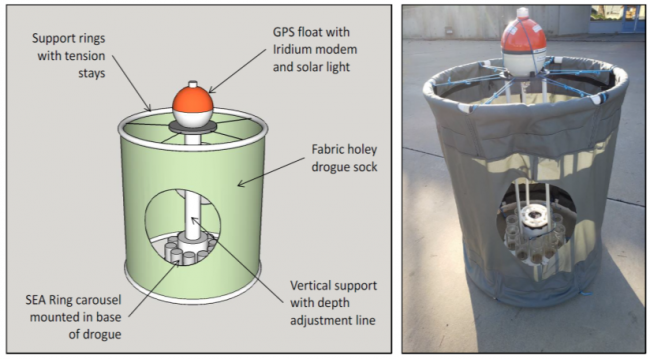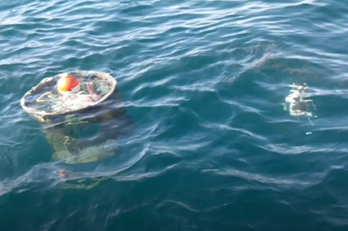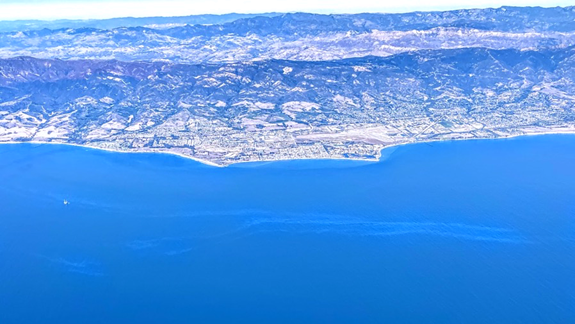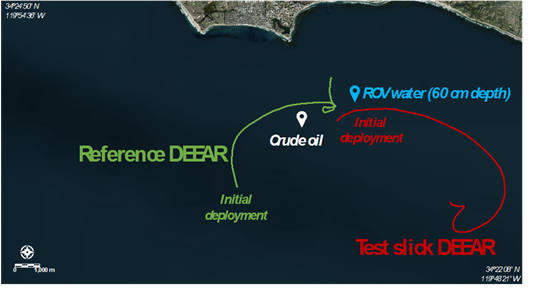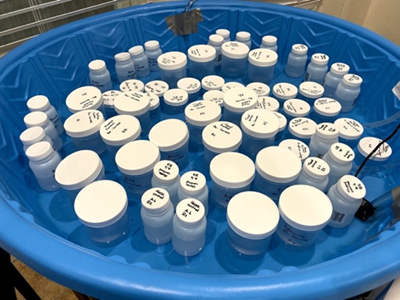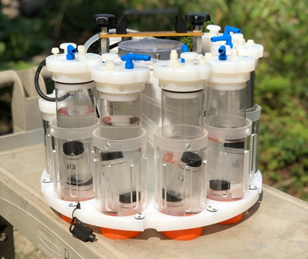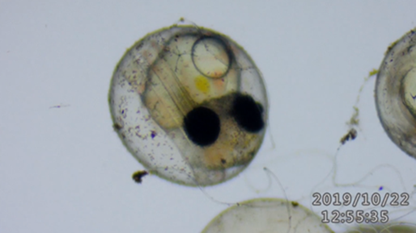This blog was originally published on April 15, 2021.

At first glance, the blue surface of the open ocean seems like an empty place. But if you look closely, life teems just beneath the surface. Tiny, transparent fish eggs, larval invertebrates, and other planktonic organisms float and drift at the mercy of wind and ocean currents.
Unfortunately, those same currents also transport oil when it’s spilled in the ocean. Oil floats because it is less dense than water, but wind and waves mix it into the ocean and under slicks. Oil slicks and oil in the water, combined with sunlight that make the oil more toxic, put marine life, especially sensitive eggs and larvae at risk.
Studying how oil spills impact life in the open ocean is challenging for several reasons. Spills can happen suddenly, in hard-to-reach locations, and conditions in the open ocean are always changing. That’s why NOAA scientists Sarah Allan and Lisa DiPinto worked with a team to design a new tool that allows researchers to conduct toxicity tests, which are traditionally done in a laboratory, in the open ocean.
This could provide new insights into the impacts of oil spills on marine life, especially early-life-stage fish and invertebrates, in the open ocean in real-time.
The New Drifting Exposure and Effects Assessment Ring (DEEAR)
Bioassays are a test of oil toxicity, the study of how (and to what degree) oil may be poisonous to living things. The Drifting Exposure and Effects Assessment Ring (DEEAR) was developed as a floating bioassay. Housing tiny test subjects, like the eggs and larvae of fish, shrimp, and other invertebrates, it’s designed to float in an oil spill and drift wherever the oil goes.
Traditionally, bioassays in the lab attempt to mimic oil spill conditions, exposing their test subjects to oil, then studying how those test subjects develop over time. They are used to understand what percentage of larval fish or fish embryos die from oil exposure, and what health problems may occur in survivors. However, it is very difficult to exactly replicate the open ocean or large oil spill in the lab.
The new DEEAR in-situ bioassay provides exciting opportunities to study oil toxicity where spills happen. In addition, the DEEAR is equipped with multiple scientific instruments and GPS trackers that can send scientists location and water quality data in real-time.
These advancements could help scientists understand the toxic impacts of oil spills faster, more accurately, and more efficiently than ever before.
Testing DEEAR Offshore
After preliminary testing, the DEEAR was deployed in the natural oil seeps near Santa Barbara, California to gauge its capabilities in offshore oil slicks.
A quadcopter drone, equipped with specialized sensors, was used to characterize the surface oil conditions and select testing locations. This is important because the DEEAR needs to be deployed where it drifts within the oil slick for the duration of the experiment.
To help scientists understand their findings, two DEEARs were used. The first was designed to drift in the oil spill for the entire 24-hour test. The second reference DEEAR was intended to float in an oil-free area 2.5 miles away.
During the daylight the units were followed with drones to track their movements in and out of oil slicks. Overnight, GPS sensors allowed for real-time monitoring. At the end both were located, retrieved, and taken back to the lab for evaluation.
DEEAR Toolkit
10 Exposure Chambers: are 9-inches long and equipped with pumps that circulate ocean water through the exposure chambers, ensuring that the test subjects are exposed to the same oil and water conditions as wild marine life. Larval fish, juvenile shrimp, and two species of fish embryos (developing eggs) were used.
Passive Sampling Devices: housed in compartments within the exposure chambers, passive samplers are made with materials that specific oil compounds stick to. They absorb oil compounds continuously throughout the experiment, similar to how organisms uptake oil from the water. At the end, the passive sampler material can be extracted-leaving scientists with only the oil compounds. This helps scientists know what types and concentrations of oil were present.
Fluorometer: measures the emission of light from oil that has absorbed a specific wavelength of light. Oil droplets produce fluorescence when they are dispersed in the water column.The higher the fluorescence, the higher the concentration of oil. This fluorometer took continuous measurements throughout the 24 hour test.
Sonde: is a water quality instrument used to measure the conductivity (salinity), temperature, and depth/pressure of ocean water.
GPS Tracker: this location tracker was set to measure its location every two seconds and update the researchers every five minutes. This allowed scientists to keep track of the DEEAR movements, address any issues, and retrieve it at the end of the 24-hours.
To ensure quality data, a remotely operated vehicle (ROV) was used to collect water samples and measure water conditions, laboratory bioassays were conducted, and scientists measured oil conditions from the boats to help compare to data collected from the DEEARs.
Results and Looking Forward
During this first-ever deployment scientist learned the DEEAR allows for real-time assessment of oil spill conditions and its effects on marine life near the ocean’s surface. It is a reliable, robust, and accurate tool in the open ocean.
In science, each unexpected challenge is an opportunity to learn. The reference DEEAR was intended to float outside the oil slick, but briefly drifted into an oil area. This taught the researchers lessons about how to deploy and track the DEEAR. Fortunately, all of the sensors on the DEEAR made it possible to interpret the bioassay results even with this unexpected exposure.
All but one of the toxicity tests was successful based on laboratory controls and the reference DEEAR. Overall, the system was able to characterize oil exposures and the effects of those exposures on organisms in the environment. This shows that the DEEAR can be used to reliably perform bioassays in the open ocean.
While further testing and fine-tuning is needed, the DEEAR presents exciting opportunities for researchers to understand the impacts of open water oil spills.
For more information, the full publication “Tracking and Assessing Oil Spill Toxicity to Aquatic Organisms: A Novel Approach” is available online in the Journal of Environmental Toxicology.

